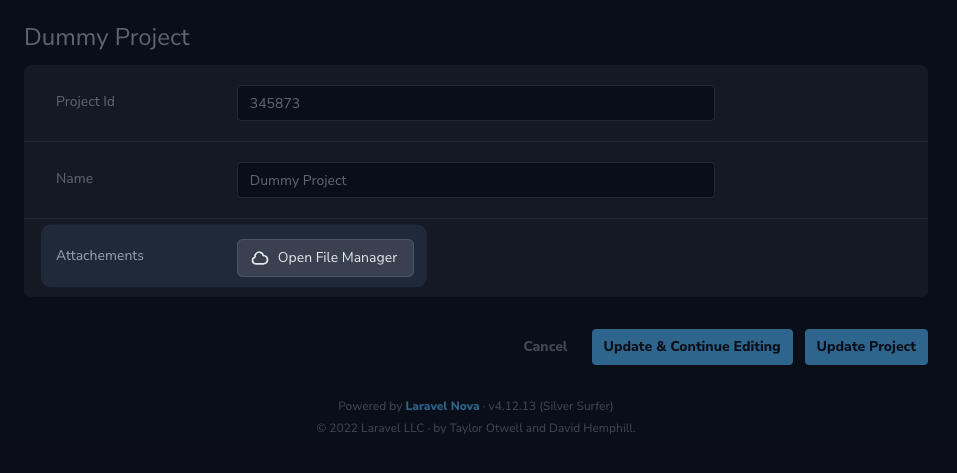Appearance
Using the field
Basic usage
You can start using the field by adding a FileManager field to your Nova resource :
// app/Nova/Project.php
use Oneduo\NovaFileManager\FileManager;
class Project extends Resource
{
// ...
public function fields(NovaRequest $request): array
{
return [
// ... any other fields
FileManager::make(__('Attachments'), 'attachments'),
];
}
}
🎉 You have now successfully added a File Manager field to your resource.

Multiple selection
When using the FileManager field on your Nova resource, you can tell the tool to allow multiple selection for your attribute.
By default, the tool will only allow single selection.
You can allow multiple selection by using the multiple method to the field. You may limit the number of selected field by using the limit method.
// app/Nova/Project.php
use Oneduo\NovaFileManager\FileManager;
class Project extends Resource
{
// ...
public function fields(NovaRequest $request): array
{
return [
// ... any other fields
FileManager::make(__('Attachments'), 'attachments')
->multiple()
->limit(10),
];
}
}
Validation
When using the field, you can specify the number of files that can be set a value for your resource's attribute.
For that, you can specifically use the following custom rule :
// app/Nova/Project.php
use Oneduo\NovaFileManager\FileManager;
use Oneduo\NovaFileManager\Rules\FileLimit;
class Project extends Resource
{
// ...
public function fields(NovaRequest $request): array
{
return [
// ... any other fields
FileManager::make(__('Attachments'), 'attachments')
->rules(new FileLimit(min: 3, max: 10))
->multiple()
->limit(10),
];
}
}
NOTE
You need to set up your field with multiple if you plan on having a minimum value greater than one, and if you expect your field to have more than one file.
Custom URL resolver
When using a multi-disk setup, the disk is saved alongside the path of your asset, however, if these two files come from different filesystems, you may want to generate an URL with your own custom business logic.
For instance, having a User resource, to which you have references for pictures and the selection was as follows :
- my-picture.jpg (from the
publicdisk) - avatar.png (from the
s3disk)
You may then use the resolveUrlUsing method to customize how the file URL is generated.
// app/Nova/User.php
use Oneduo\NovaFileManager\FileManager;
use Oneduo\NovaFileManager\Rules\FileLimit;
class User extends Resource
{
// ...
public function fields(NovaRequest $request): array
{
return [
// ... any other fields
FileManager::make(__('Pictures'), 'pictures')
->resolveUrlUsing(function (NovaRequest $request, string $path, string $disk, Filesystem $filesystem) {
if ($disk === 's3') {
return $filesystem->temporaryUrl($path, now()->addMinutes(5));
}
return $filesystem->url($path);
})
->limit(3),
];
}
}
Third-party compatibility
You may want to use the field inside a custom field or a tool (e.g Nova Settings or Laravel Nova Flexible Content). Some extra configuration is needed to be able to resolve the field during api calls.
You may register a wrapper which is callback to configure the field (filesystem, permission, etc.) :
// app/Providers/NovaServiceProvider.php
<?php
namespace App\Providers;
use Illuminate\Support\Facades\Gate;
use Laravel\Nova\Fields\Text;
use Laravel\Nova\Http\Requests\NovaRequest;
use Laravel\Nova\Nova;
use Laravel\Nova\NovaApplicationServiceProvider;
use Oneduo\NovaFileManager\Casts\Asset;
use Oneduo\NovaFileManager\Casts\AssetCollection;
use Oneduo\NovaFileManager\FileManager;
use Oneduo\NovaFileManager\NovaFileManager;
use Outl1ne\NovaSettings\NovaSettings;
class NovaServiceProvider extends NovaApplicationServiceProvider
{
public function boot()
{
parent::boot();
NovaSettings::addSettingsFields(function () {
return [
Text::make('Some setting', 'some_setting'),
FileManager::make('An image', 'image')
->wrapper('my_wrapper'), // indicate which wrapper to use
];
}, [
'image' => AssetCollection::class, // do not forget to cast
]);
}
// ...
public function register()
{
FileManager::registerWrapper('my_wrapper', function (FileManager $field) {
// configure the field as you used to
return $field
->multiple()
// ...
->filesystem(fn() => 'public');
});
}
public function tools()
{
return [
NovaFileManager::make(),
NovaSettings::make(),
];
}
}